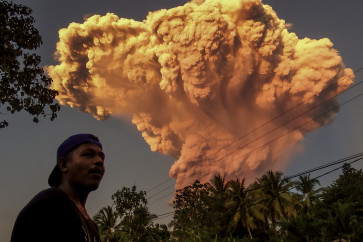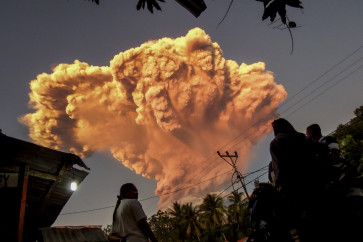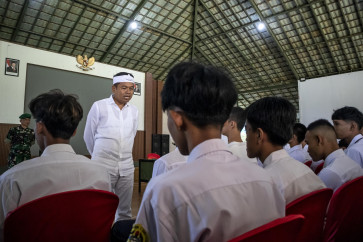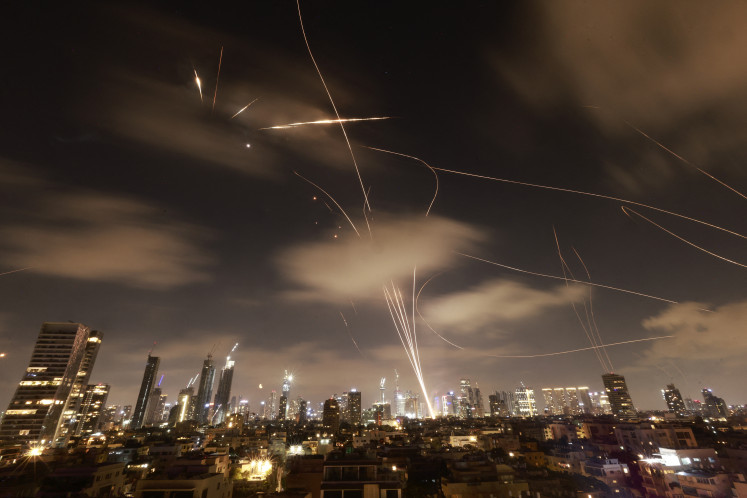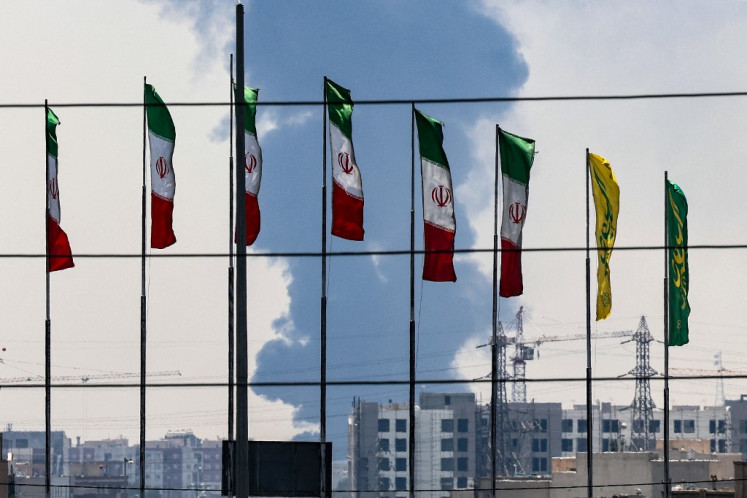Popular Reads
Top Results
Can't find what you're looking for?
View all search resultsPopular Reads
Top Results
Can't find what you're looking for?
View all search resultsSlums transform overnight into tourist spots
Rainbow hill: Pastel-hued houses perch on Brintik Hill, Wonosari in the Central Java capital of Semarang
Change text size
Gift Premium Articles
to Anyone

R
ainbow hill: Pastel-hued houses perch on Brintik Hill, Wonosari in the Central Java capital of Semarang. Although the project is still under construction, it is already drawing many visitors. (JP/Suherdjoko)
Inspired by success stories in Yogyakarta and Malang, an increasing number of slum areas in major cities across Indonesia have transformed into new colorful quarters worthy of sightseeing. The Jakarta Post writers Corry Elyda in Jakarta and Aman Rochman in Malang take a closer look at how the trend is sparking a new social media craze.
A slum neighborhood in Krendang, West Jakarta, was ablaze with colors on a recent afternoon. The walls of the houses, which lined a sparkling alley, were emblazoned with murals depicting popular cartoon characters. It appeared that the quarter had shed its stinky image.
Unlike anywhere else in Tambora district, which is notorious for fires, gutters in Krendang became surprisingly clean — at least by local standards. The alley came to life at around 3 p.m. with lots of children playing their favorite games in the absence of decent playgrounds.
“Here we can play and admire the cartoons on the walls,” said Samsul Ikhwal Nugraha, 10, who was staring at a picture of a minion, a character from Despicable Me.
The neighborhood that otherwise lacks breathing space now boasts a public garden that helps create a relaxed ambience for its 17,000 residents. The artistry and cleanliness is unusual for a Jakarta slum area. It all began in 2016 after Krendang took part in a cleanliness contest held by the city administration. Before then, it was a neighborhood that lacked cleanliness and suffered from flooding problems when the banks of the nearby Krendang and Cibubur rivers burst.
As locals would proudly recall, the neighborhood unit had the honor to represent West Jakarta after winning a provincial cleanliness contest. The achievement came as a result of the “Clean and Colorful Alley” campaign, which brought together the community and encouraged them to keep their neighborhood more livable.
“Awareness on keeping the environment clean has been instilled in every resident,” said Maman Sumantri, 40, a neighborhood unit head.
Andre Ravnic, the Krendang subdistrict chief, attributed the victory to the community’s effort to transform their neighborhood by way of tree planting, environmental cleanup and mural painting. “Because the concept turned out to be good, we promoted it and encouraged other neighborhoods [in Krendang] to follow suit.”
Now, all seven community units in Krendang have at least one “clean and colorful” alley. Each community unit manages a 100 to 150 meter alley. They are free to have any theme painted on their walls by artists but the most popular design involves cartoon characters.
Krendang is not alone in the growing number of urban kampung in major cities where visitors can admire cute pastel-hued houses — a trend that has developed into a new hype in recent years. Although the beautification of urban kampung has yet to develop into a national movement, cities like Semarang, Yogyakarta and Palembang in South Sumatra and Balikpapan in East Kalimantan are making changes. As of today, at least nine cities and towns boast “rainbow villages” and more are starting to develop ones.
Yogyakarta, Indonesia’s second best known tourist destination after Bali, was the first to paint houses colorfully. It did so along the Code River in 2015, taking inspiration from the famed the favelas in Rio de Janeiro, Brazil.
Santorini of Java
For world travelers, a neighborhood painted in Technicolor may bring their memories back to fabulously famous places as the rainbow Gamcheon Culture Village in Busan, South Korea, Sidi Bou Said in Tunisia or Cycladic houses in Greece.
Indonesians paint their modest houses, fences or even food stalls bright for various reasons. In Jakarta, they do it largely with communal orderliness in mind. In East and Central Java, they do it for the lofty goal of boosting tourism, which takes a lot more time and effort, and with payoffs that are not immediate. But this seems to be no big issue today, as adventurers are constantly looking for pictures to share on Instagram and other social media platforms.
Obviously, that is what has happened with the Colorful Village of Jodipan in the East Java town of Malang. It may not be as well-known as Gamcheon, but it is fast gaining popularity in Indonesia and overseas thanks to media hype.
Once a slum area by the river of Brantas, Jodipan’s status has risen to a must-visit tourist spot in Malang, where — until 2016 — holidaymakers have known little else about it other than the scenic mountains of Batu. Much credit goes to the imaginative students of Malang Muhammadiyah University (UMM) who came up with the makeover idea and made it happen with the help of the government and private entities.
The Malang administration has officially designated the hilly area with steep alleyways and sharp turns a tourist village, coughing up billions of rupiah for waste management and parking lot construction. Cafes and shops have been mushrooming there to cater to the increasing number of local and foreign visitors, which can top 3,000 on weekends. Gone is the foul reputation that used to keep tourists away.
“The area is now clean and the locals’ economy is improving,” Malang Mayor Mochamad Anton said.
Other cities’ success has inspired the administration to develop more thematic villages across the region, from smart villages to white villages, with the latter drawing inspiration from Santorini, the famous southernmost island of Greece’s Cyclades islands in the Aegean Sea. The goal is to attract tourists who would usually treat Malang as a mere transit point on their way to Mount Bromo and Batu, two traditional tourist destinations near the city.

Bright prospects
The Jodipan success story is contagious. Semarang, the capital of neighboring Central Java, is the latest to have jumped into the fray with the local government spending around Rp 3 billion (US$218,000) to start a project to give a rainbow makeover to 500 houses on the Brintik Hill in Kalisari village.
Kampung Pelangi (Rainbow Village) has become Semarang’s new tourist attraction, bringing in a growing number of visitors, although it is still a work in progress. People visit to take photographs that they share on social media. It started off as a Rp 9.6 billion renovation of the Kalisari Flower Market.
“But when the market project was completed in December [2016], we thought the area would be even more beautiful if the slum area in the background was revamped as well,” Semarang Regent Hendrar Prihadi said.
The south of Semarang is famous for gorgeous hills, lush greenery and cool air. The ongoing village makeover is expected to draw more visitors to the city, which is renowned for colonial era buildings and Javanese cuisine. The ongoing project seems propitious thanks, again, to social media, where users post pictures of them posing in the village.
From the start, the village has been designed to have a touch of art. Artists have been working on murals depicting characters of Javanese shadow puppets, memes and popular comic characters, among other things.
To enhance the new holiday spot, new infrastructure like roads and waterways as well as food courts, parking lots and souvenir shops will be built. A major attraction is a tower that provides a bird’s eye view from the top of Brintik Hill.
Hysteria, a community of young art and urban development activists, has been involved in the project. Artist Akhmad “Adin” Khoridin founded Hysteria in 2012 with a mission to improve people’s awareness about the need to enhance their neighborhoods. He describes his work as an “ethnographic job”.
“We mingle, make friends, find out what’s interesting about their villages and identify potentials,” he said.
The community came up with the idea of creating mural art and installations as well as holding workshops. Content, history, myth and folklore began to be visualized. The program has been implemented in eight kampung across Semarang with various financial schemes.
“Sometimes, we chip in to buy paint, for example. The residents may give us food. When we earn money from other commercial projects, we will cover everything,” he said.
One of Hysteria’s more notable works is in Kauman, where it transformed a quiet, spooky corner into a vibrant exhibition venue and community library. Now, alleys are clear of parked motorcycles with the presence of a communal parking lot.
In Jakarta, urban development planner Elisa Sutanudjaja praised the beautification efforts but she noted that the works had been initiated for short-term goals and specific localities.
In densely populated areas like Tambora, she argued, residents needed more than just clean and colorful alleyways — they needed more fire extinguishers and flood control infrastructure. A quarter will usually receive proper attention from the local government only if it is productive.
“City governments should never neglect the obligation to revamp slum areas and provide basic necessities like water, decent housing and sanitation for all,” she said.
Without strong long-term support from the government, the tourism goals may not be sustainable. Residents would need a great deal of financial and human resources to keep their villages attractive for tourists for many years to come.
— Supriyono Hemay contributed to this story from Jakarta.

